Ground robotic systems in Special Operations
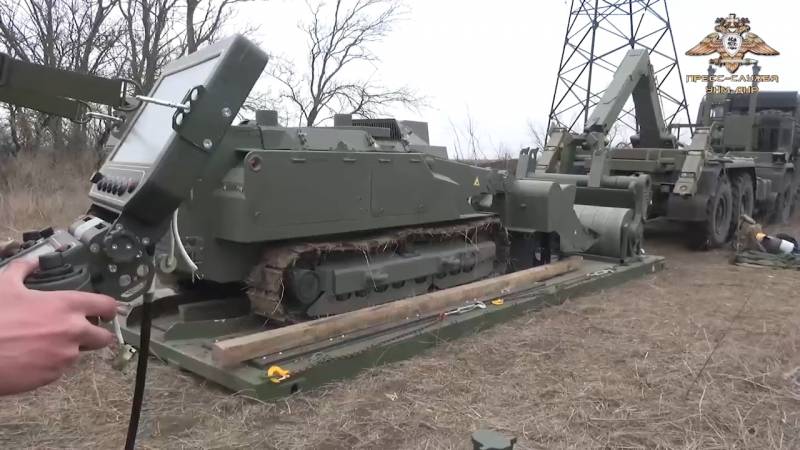
Unloading RTK "Uran-6" somewhere in the Donbass, April 2022. Photo by UNM DPR
As part of the ongoing operation to protect the Donbass, the Russian army uses ground-based robotic systems of various types. Some samples of this kind are already well known to the public and this is not the first time they solve real problems. Others were previously tested at test sites, but did not participate in military operations. All together they should help achieve the goals of the Special Operation and solve some other problems.
Humanitarian mission
One of the most common and well-known domestic ground-based RTKs is the engineering Uran-6, designed to clear the area from mines, explosive devices and various ammunition. In the past, such equipment was repeatedly used to combat minefields in different regions of our country and foreign countries.
Already in the spring, in April-May, the Uran-6 complexes appeared in the liberated areas of Donbass. With the help of standard trawls of various types, remote-controlled vehicles cleared individual passages and entire sections near the combat zone. In the future, as our troops advance, Robots went to new areas that needed demining, incl. in the newly annexed regions.
Reportedly, the Uran-6 RTK has so far cleared large areas in four new regions. Most of the time they had to work on agricultural land that had recently been battlefields. Due to the long and systematic work, the complexes cleared large areas - strip after strip.
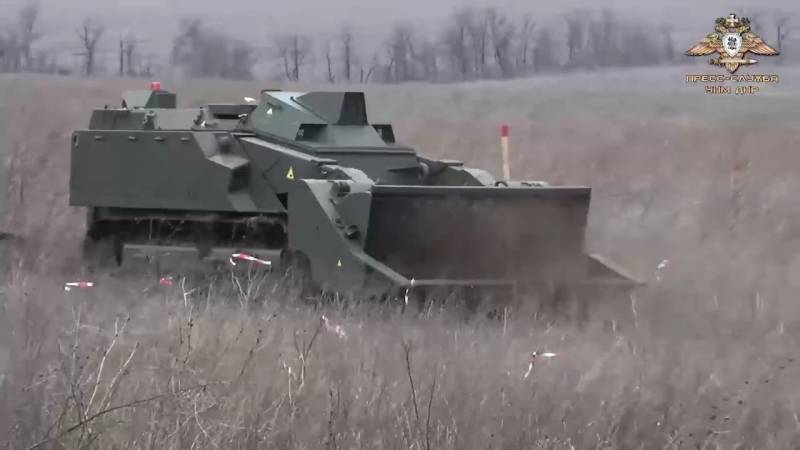
The robot clears the lane. Photo UNM DPR
Work was also carried out on the territory of settlements. So, "Urany" made a great contribution to the clearance of the city of Mariupol, incl. industrial buildings recaptured from the enemy. In the summer, Ukrainian formations began to bombard the cities of Donbass with anti-personnel mines. Engineering robots were involved in the elimination of this threat.
Recall that the Uran-6 product is a remote-controlled tracked vehicle capable of using various attachments. Several types of trawls and other engineering tools have been developed. The RTK is capable of fighting against anti-personnel mines or other low-mass munitions. Trawls destroy them by undermining them. The robot is controlled from a remote operator console. The operator controls the operation of the RTK using telemetry and a signal from several cameras.
heavy sample
RTK "Uran-6" is capable of neutralizing only small explosive devices, while heavier and more powerful ammunition can damage its design. In this regard, the Russian army has other engineering tools that can deal with heavier mines. Recently, in this category of equipment there is a robotic complex - the product "Prokhod-1".
RTC "Prokhod-1" was developed several years ago and is still being tested and demonstrated at exhibitions. In July 2022, an engineering vehicle of this type was first seen on the territory of Donbass. At that time, a short video appeared on specialized resources showing the process of clearing the field, incl. detonation of ammunition under the trawl.
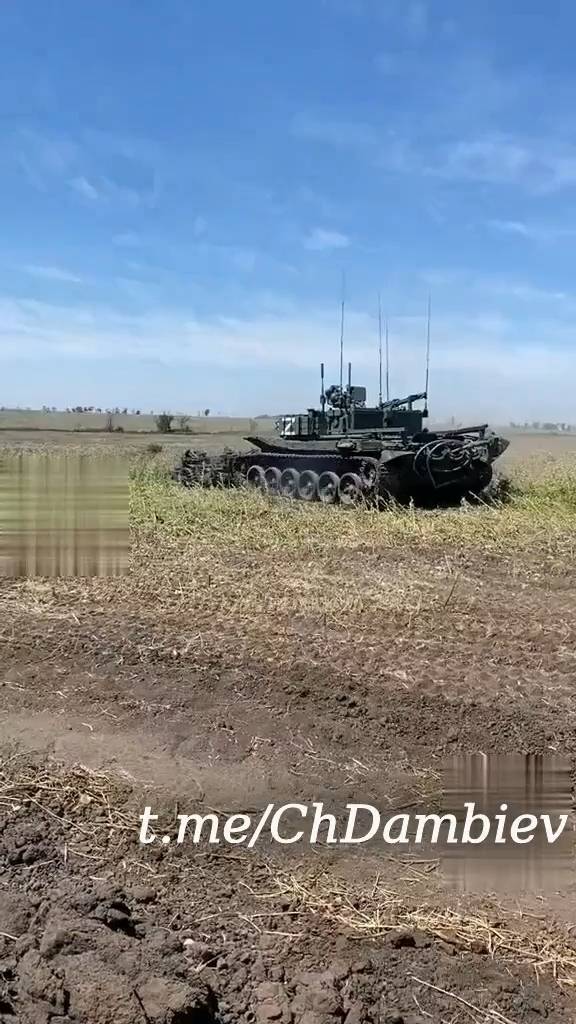
Complex "Prokhod-1" at work, July 2022. Photo by Telegram / ChDambiev
However, new information about the use of "Passage" in the zone of the Special Operation has not been received since then, and the reasons for this are unknown. Perhaps the RTK was sent to the Donbass temporarily, and after such tests were carried out, it was returned home. Also, it cannot be ruled out that the heavy complex completed all its tasks in the summer, and now its work is not required. At the same time, it can be assumed that Prokhod-1, along with the lighter Uraniums, continues to clear the area, but simply does not receive due attention.
The Prokhod-1 heavy robotic complex was developed on the basis of the BMR-3M Vepr armored demining vehicle and is actually its specialized modification. When it was created, the chassis was saved tank T-90 with a special superstructure, target equipment in the form of trawls, etc. At the same time, remote control means appeared on board the armored vehicle - a communication system, a set of cameras and actuators. It is curious that the RTK still has regular jobs in the habitable compartment, and it can work under the direct control of the crew.
On the fields of Donbass, the Prohod-1 RTK used a continuous tank mine trawl of the TMT-S type. On the frame of such a trawl there are a large number of heavy rollers placed in two rows. With their help, anti-personnel and anti-tank mines are detonated and a passage is cleared sufficient for the movement of equipment and people. The TMT-S is also equipped with attachments for remote detonation of mines with an electromagnetic target sensor, a minesweeping device for anti-aircraft mines and a station for suppressing radio channels for controlling explosive devices.
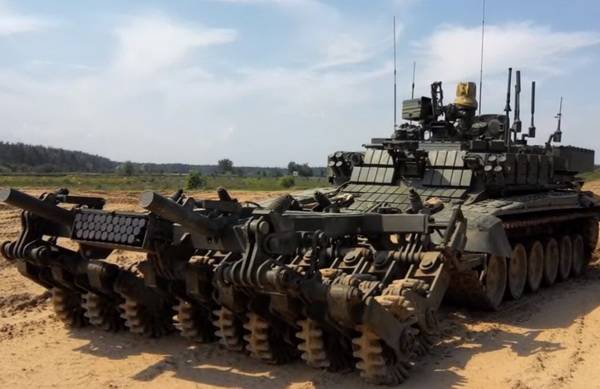
"Pass-1" on trials. Photo VNII "Signal"
Test platform
The other day it became known that in the near future military tests in the zone of the Special Operation will be held by another promising robotic complex. On January 24, the former head of Roscosmos, Dmitry Rogozin, said that the Marker multi-purpose RTK would be sent to the Donbass for verification.
Already in February, three robots of this type will be delivered to the area of the Special Operation. Plans are reported to test unified platforms with reconnaissance and combat equipment. Such equipment will have to conduct reconnaissance of the area, detect enemy targets and issue target designation to fire weapons. The reconnaissance robot will observe the situation both by its own means and with the help of a tethered drone-multicopter. The standard UAV of the complex is capable of climbing to a height of up to 150 m and remaining in the air for a long time - power supply via cable from the RTK board removes restrictions in this area. The optics of the drone has an observation range of up to 20 km.
The combat version of the Marker will have to use different weapons options. Combat modules with a large-caliber machine gun, an automatic grenade launcher and a missile system will be tested by practice. With the help of such weapons, the RTK will be able to fight manpower, unprotected equipment and some enemy armored vehicles.
It should be noted that not only technical means will be tested under the conditions of the Special Operation. One of the main goals of the Marker project is to create new software that can work on operator commands or act with a given degree of autonomy. Apparently, in the course of future work in the zone of operation, the RTCs will work mostly independently, only under the supervision of operators.
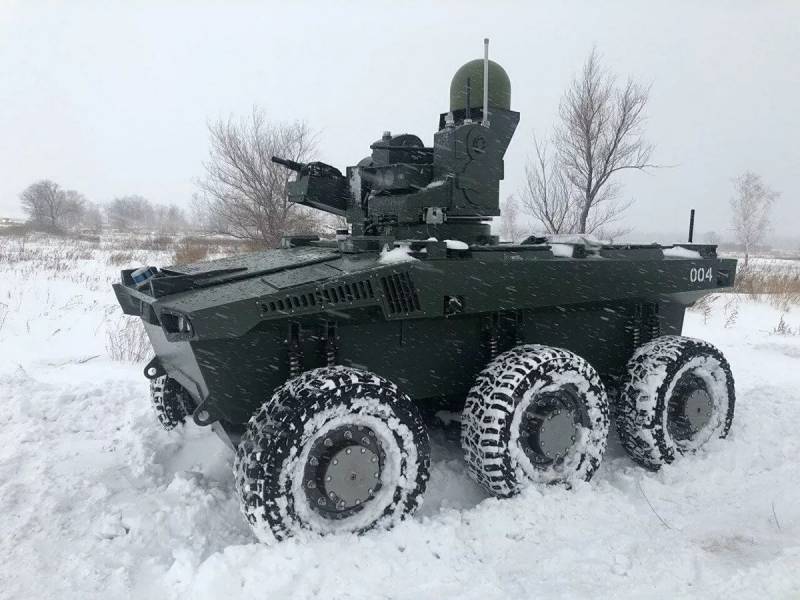
Experienced robot "Marker" on a wheeled platform. Photo "Android technology"
News about "Marker" are of great interest. First of all, the very fact of the deployment of a new complex in the combat zone is curious. In addition, the goals of the Marker project related to the further development of robotics should be remembered. All this means that the course and results of future tests of three multi-purpose RTKs will not only show the results of this project, but will also affect the further development of domestic military robots.
Present and future
The potential of the robotic direction has not raised questions for a long time, and various complexes of this kind with certain functions are being developed for the army. Some of these samples have already been adopted, while others are only being tested. At the same time, both of them fall into the zone of the Special Operation and solve real problems.
Serial and experienced RTK perform the necessary work of various kinds and contribute to the achievement of the overall goals of the operation. In addition, it becomes possible to carry out additional testing of technology and find ways for its further development. Thus, robots help people in difficult and dangerous areas of work and at the same time contribute to the further development of a promising area of science and technology.
Information